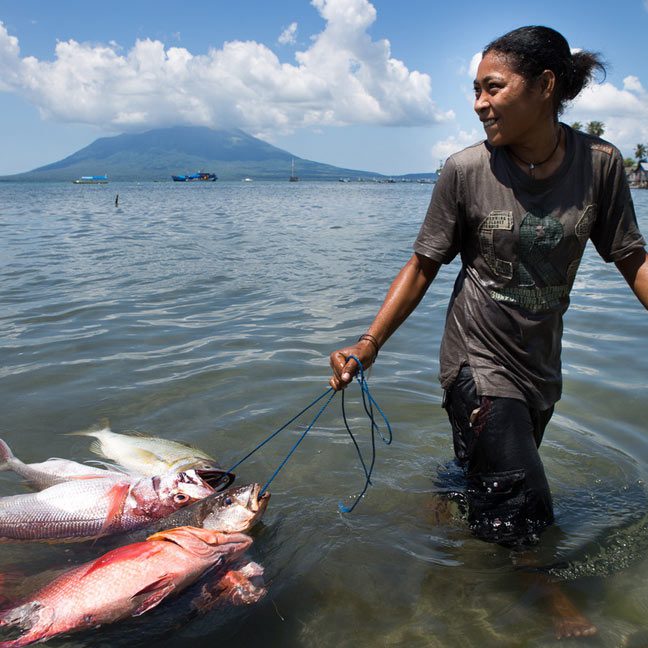
HELP SAVE LIVES
Right now Oxfam is responding to emergencies around the world, including the recent earthquake and tsunami in Indonesia.
Locals could almost run faster to market
By Juan Martorana – blogging from Indonesia
Lewoleba — one of the main villages on Lembata Island — is a long way east of Wareng Village where I left our last Female Food Hero, Ibu Par. But the car trip to Yogyakarta, the flight to Larantuka on Flores via West Timor’s capital, Kupang, and then the ferry from Larantuka to Lembata Island, felt like nothing compared to the 80 kilometre round-trip I made from Lewoleba to Hoelea on my second day here. This road trip (in every sense of the word) took a mammoth 10 hours by car: or an average of just 8km/h.
Access to land is a big issue when it comes to solving food security in Indonesia. Our host in Lembata, Ibu Siti Rofi’ah, makes this as clear as Ibu Par did when I visited her in Java. But there is no one-size-fits-all answer to ensuring food security for the one-in-eight people who are still going hungry around the world every day. It is a complex problem, and building food security needs an equally sophisticated response. One that is tailored to the needs of those experiencing the hunger. And if the state of the roads between Lewoleba and Hoelea are any guide to the rest of Lembata, then this is certainly a factor that is limiting the amount and types of foods making it to market here. The flow-on effect is a limit to the incomes that people can make, as well as the range of foods they can access beyond the larger villages.
In both rich and poor countries, the amount of food wasted is about the same: 30%. But while in countries like Australia the waste is from the consumer, in Indonesia and many other developing nations, most waste occurs at the producer level. Not because of laziness or lack of care, but because they just don’t have the resources we take for granted. There is for instance little suitable storage for grains, and animal products like fish. But also the road networks and associated transport infrastructure are often insufficient to get produce to market before it goes bad.
I heard this on my first day in Lembata. Fishers with small boats and nets are limited in the catch they can make. But ensuring a secure livelihood is further undermined by an inability to get their fish to buyers before it goes off in the intense heat here. Fishers haul in what they can with the hope of finding a buyer and boosting their family’s livelihood, but without suitably refrigerated transport and storage, many fish are simply becoming food for maggots.
As I crawled to Hoelea on a road with potholes that were as big as the pig and goat pens of the surrounding farms, I stumbled across Ibu Silosor Barga drying Ikan Selar (Selar Fish) on a sheet of plastic under the blazing mid-morning sun.
Ibu Silosor’s husband is a fisherman. He leaves the beach and is at his Bagan — a wooden fishing platform out to sea — by 6pm; he got back at 5am today Silosor tells me. Ibu Silosor, has already salted her husband’s overnight catch of fish and stingray. She hopes to sell a “chain” of 30 dried fish for around 20,000 rupiah — but before you get excited, remember that’s only about two Australian dollars.
I’ve heard a couple of times now in Indonesia, the poorest of the poor being described as “lazy”; but I’m not so sure. “Every day my husband goes to the platform; every day unless there is a full moon [when fishing is almost futile],” Silosor says. Life for families like Ibu Silosor’s is just damn hard. And working those hours, day in and day out — for a sum of money that affords very few, if any, of life’s luxuries, let alone school for her kids or adequate health care — must wear all but the most hardy down. Silosor explains: “I wake up at 4.30am. I prepare the children to go to school and feed them. I did the dishes, washing clothes and cleaning house [before leaving to] meet my husband at the beach at 7am.”
“It is difficult to make a living. My husband is not lucky when he is fishing. Many times we did not get as much as we hoped,” she says. “When we are lucky he can make 100,000 rupiah [AUD $10]. But many times [we make] under 30,000 rupiah [a day],” she tells me. Unsurprisingly, Ibu Silosor says, “This is not enough.” With an average weekly income estimated by her at AUD $20 to 30, she tells me that her husband would like “bigger nets, and a bigger boat with a boat machine, so he can get further out to sea.”
But then many people cannot always sell what they do catch with the roads the way they are. So again I’m reminded that food security is a jigsaw puzzle, requiring many unique pieces to solve; pieces that have to be placed in a particular way depending on the problems faced by individual communities..
Find out the dreams of those in Hoelea next post as I pull in there around mid-afternoon.
part 1 | part 2 | part 3 | part 4 | part 5 | part 6 | >> part 8